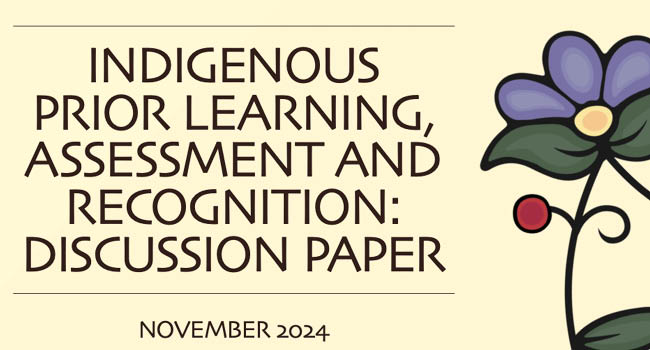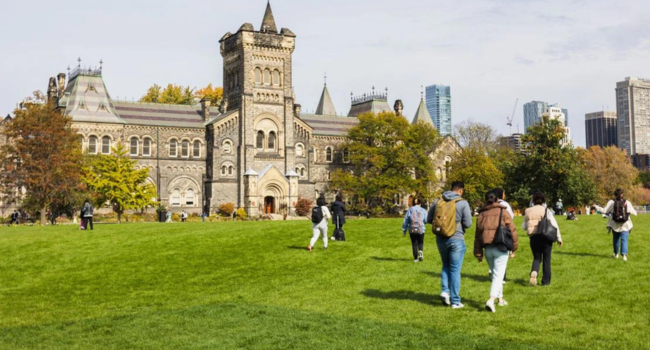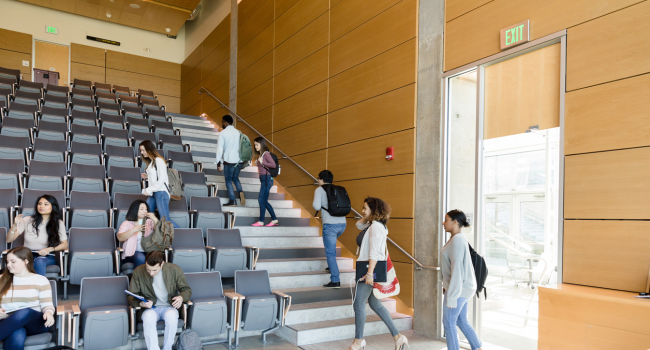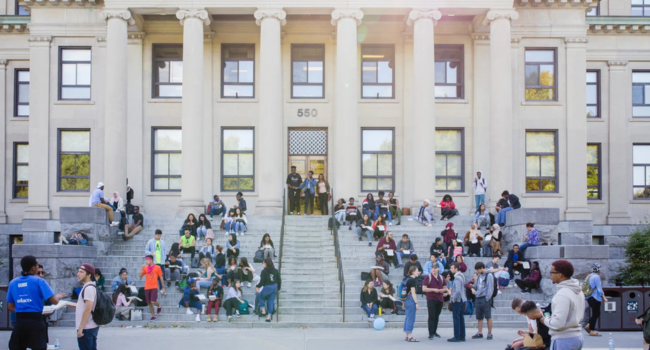Research
Research
(Re)Defining Transfer: Key Learner Mobility Terminology in Ontario
Jeffrey Napierala and Emerson LaCroix (ONCAT)
Recognition of Military Education and Training within the Ontario Postsecondary System
Donald Moore (Portage College, CMVF3C) and Suzette Brémault-Phillips (University of Alberta, CMVF3C)
Over 10,000 members of the Canadian Armed Forces (CAF) transition to civilian life annually, often encountering barriers to employment and further education. Despite possessing extensive training and experiences, many military-connected learners struggle to have their technical, leadership, and organizational skills and competencies formally acknowledged or translated into civilian credentials. This persistent disconnect between military training and civilian credentialing continues to limit access to postsecondary programs and career opportunities.
The development of structured mechanisms for the recognition of Military Education and Training (MET) within Canada’s postsecondary education system has garnered increasing attention. In particular, colleges and polytechnic institutions have demonstrated potential in supporting military-connected learners through short-term, skills-based programs that align with workforce demands while acknowledging existing expertise.
This report synthesizes national and provincial research to understand current practices, barriers, and strategies for improved recognition of military learning at postsecondary institutions, ultimately informing policy development and fostering systemic change across Canada’s education and employment landscapes.
What the 2024 University/College Applicant Study Tells Us About Transfer
Jeffrey Napierala (ONCAT)
The University/College Applicant Study (UCAS) is an annual survey conducted by the Academica Group that gathers insights about applicants to postsecondary institutions across Canada. Since the mid-2000s, the UCAS has collected and shared valuable information about the motivations and factors that influence students’ decisions related to postsecondary education. In 2023, ONCAT partnered with Academica to expand the survey’s consideration of student mobility and transfer experiences in Ontario. This partnership introduced new questions focused on students’ educational backgrounds, reasons for transferring, and overall expectations. In addition, it enabled Ontario institutions to participate in the survey at no cost.
The UCAS offers a broad view of how students make decisions about their postsecondary education. This report specifically focuses on the questions that were added by ONCAT — which explore student mobility and transfer experiences.
Findings From the Transfer Intent Survey
Jeffrey Napierala (ONCAT)
This report presents results from the Transfer Intent Survey (TIS), an online survey conducted by ONCAT of students’ interested in transferring to postsecondary institutions in Ontario. The purpose of the TIS was to generate insights into the early stages of transfer-related decision-making. The results cover a variety of topics on potential transfer students, such as their backgrounds, intended transfer destinations and programs of study, experiences and expectations regarding the transfer process, the impact of COVID-19 pandemic on their decisions, and their engagement with ONTransfer.ca.
The TIS was the first wave of data collected as part of a larger project known as the ONCAT Longitudinal Study of Transfer Students (OLSTS). The broader OLSTS project was a mixed-methods data collection initiative that followed students from the initial stages of considering transfer through their first semester of study at their receiving institution. The key objectives of OLSTS were to:
- Enhance our understanding of Ontario’s unique transfer landscape.
- Gain insights about the transfer process from the perspectives of students.
- Collect data at multiple timepoints along the transfer journey to provide a more comprehensive understanding of students’ experiences.
- Inform transfer policies and practices at postsecondary institutions.
- Provide evidence-based recommendations to the government.
Work-Integrated Learning Eligibility for Transfer Students: Insights From an Environmental Scan of Ontario College and University Websites
Emerson LaCroix and Jeffrey Napierala (ONCAT)
Work-integrated learning (WIL) is an important component of the Canadian postsecondary system. There are numerous benefits to students who participate in WIL, such as learning about workplace culture, developing soft and hard skills, and earning more in the job market following graduation. To date, the WIL literature has focused predominantly on “traditional” postsecondary students who directly enter postsecondary studies after high school. Unfortunately, this focus does not explicitly consider transfer students, who have unique personal and academic backgrounds that may impact their eligibility to participate in WIL. Building on recent transfer research suggesting that transfer students can face challenges accessing WIL opportunities, in this report, we examine transfer and WIL information on college and university websites. Since institutional websites are often a starting point for students to learn about transfer, it is important to understand the information they provide students and identify areas of growth to better support transfer.
How Do Students Learn About Transfer?
Emerson LaCroix and Jeffrey Napierala (ONCAT)
Research has identified numerous information sources that students use to learn more broadly about their possibilities for transfer and the transfer process. While studies have also begun to consider the interplay between information sources, almost all of the existing research is situated within the American transfer context, which focuses heavily on student transfer between community colleges and four-year universities. In Ontario, our postsecondary system is distinct, and postsecondary institutions offer numerous types of credentials with the possibility for students to transfer in myriad directions. For these institutions, knowing the information sources that students access and how they use this information is crucial for developing effective transfer policies and practices. To support the sector in this endeavour, in this report, we examine the process through which students gather information as they make decisions about transferring. Importantly, by focusing on the pre-transfer stage, we can identify not only the information sources students use but also how they combine and make sense of potentially conflicting information and fill information gaps.
Technology-to-Engineering Transfer Pathway: Institutional Stakeholders’ Experiences and Perspectives
Melissa McLeod, Jennifer Thompson, Kimia Moozeh, and Brian Frank (Queen’s University)
Creating pathways for college students to enter university programs is a great way to enhance accessibility and promote diversity in competitive career paths, such as engineering programs. Queen's University recently developed a pathway for students who have completed an engineering technology diploma at one of several participating Ontario colleges.
To better understand how to support students following such a pathway, the authors of this study conducted a series of interviews with staff and faculty at postsecondary institutions across Canada.
Indigenous Prior Learning, Assessment and Recognition: Discussion Paper
Lana Ray (Athabasca University), and Anita Vaillancourt (Lakehead University), with Celine Wick and Laika Beaulieu.
Informed by a scoping review, case study interviews and discussion circles with PLAR practitioners and administrators, this paper explores the possibilities and considerations of Indigenous PLAR in post-secondary institutions in Ontario. Although this discussion paper is relevant to all sectors of post-secondary education, there is an emphasis on PLAR in the university sector because of the significant knowledge and practice gaps present in the sector. For the purposes of this paper, Indigenous PLAR is defined as PLAR that includes Indigenous knowledge systems in design and implementation and/or recognizes Indigenous and community knowledges for use with Indigenous learners. This discussion paper is divided into three sections: PLAR in Indigenous contexts, equivalencies, and assessment.
1. The first section addresses the question of, “Why PLAR in Indigenous contexts?” It seeks to understand how PLAR can improve access and attainment of post-secondary education for Indigenous peoples. It explores the potential benefits of PLAR for Indigenous students, convergences between the learning assumptions that underpin PLAR and Indigenous knowledge systems’ assumptions about learning, and the convergences between PLAR, western learning theory and Indigenous learning theory.
2. The second section focuses on equivalencies and explores the question, “What types of prior learning in Indigenous communities are equivalent to accredited learning?” Types of prior learning that have received recognition or show promise of receiving recognition in a post-secondary setting and potential methodologies to map and confirm equivalencies are discussed.
3. The final section of this discussion paper focuses on the assessment of prior learning, including promising principles and methods to undertake assessment. It seeks to address the question, “What types of processes can assess equivalencies in a culturally responsive and effective manner?”
Postsecondary Education Credential Accumulation Pathways and the Intergenerational Reproduction of Inequalities
Xavier St-Denis and Claudia Nono Djomgang (Institut national de la recherche scientifique)
Education has long been identified as a key catalyzer of inequalities. For example, education can contribute to the reproduction of inequalities from one generation to the next (Aurini et al., 2020; Bourdieu & Passeron, 1964; Calarco, 2018; Lareau, 2003). This occurs when two conditions are met: 1) higher levels of educational attainment are associated with higher income; and 2) there is inequality in access to education based on social origins, meaning that children from more privileged families are more likely to achieve higher levels of education (Simard-Duplain & St-Denis, 2020).
On the other hand, research has also identified equalizing effects of postsecondary education (Hout, 1988; Mare, 1980; Torche, 2011). This research tends to show that inequality between bachelor’s graduates with various family backgrounds tends to be smaller than the level of inequality between individuals with various family backgrounds observed in the overall population. In other words, this research tends to suggest that inequality between individuals of more or less privileged backgrounds would be stronger without the expansion of higher education observed in North America and Europe over the last few decades (Bloome et al., 2018; Pfeffer & Hertel, 2015). This equalizing effect can occur at the same time as inequalities in access to PSE occur, with one dynamic possibly counteracting the other. Those findings usually rely on data from the US. It is not clear to what extent they transpose onto the Canadian context. Moreover, they rely on cross-sectional measures of education that take into account the highest level of education attained by individuals, but not the specific pathways they may take into PSE.
The second shortcoming is especially consequential given two sets of findings in the Canadian context: first, different pathways through PSE are associated with substantial income disparities. For example, individuals who complete a bachelor’s degree as their first credential and who pursue no further PSE tend to earn more than those who complete a college certificate or diploma before graduating from a bachelor’s program (St-Denis et al., 2021; Walters, 2003). Second, family background appears to be associated with different dimensions of PSE pathways, especially graduating from a second PSE program after completing a first program (St-Denis et al., 2021).
In this report, we set out to explore whether differences in the likelihood of following certain PSE credential accumulation pathways depending on parental education contributes to the intergenerational reproduction of disadvantage among children of less educated parents.
Apprenticeship and Future Income Earnings: Toronto and Ontario
Robert S. Brown (York University), David Walters (University of Guelph), Gillian Parekh (York University), Ryan Collis (York University), Christine Mishra (University of Toronto), and Firrisaa Abdulkarim (York University)
This report is the third in a three-part series. To view the first report, click here. To view the second report, click here.
This report is based on an Ontario-wide analysis of students who pursue apprenticeship programs and makes comparisons between those who attended high school in the Toronto District School Board (TDSB) and those who did not. The statistical analysis is based on administrative data linkages between the TDSB and Statistics Canada’s Educational Labour Market Longitudinal Platform and provides invaluable insight into the relatively unexplored relationship between public school variables and apprenticeship outcomes. It also provides insight into how similar or disparate postsecondary outcomes are for students within and outside of the TDSB.
The statistical analyses mostly focus on a series of descriptive statistics that describe the types of apprenticeships that students pursue, their age of initiation, program duration, graduation rates, and gender. One of the key findings from this report is that securing a Red Seal or non-Red Seal certificate is incredibly challenging. Across Ontario, just over a third of students (36%) who enter a Red Seal or non-Red Seal apprenticeship program successfully obtain a certificate within six years. For students from the TDSB, the proportion is even lower at 26%. The results also reveal that students outside of the TDSB tend to fare better financially compared to their counterparts within the TDSB across most of the variables. These and other significant findings are highlighted in the report, along with possible explanations for the results.
A Focus on the Role of Transfer, Apprenticeship Outcomes, and Future Income Earnings
Robert S. Brown (York University), David Walters (University of Guelph), Gillian Parekh (York University), Ryan Collis (York University), Christine Mishra (University of Toronto), and Firrisaa Abdulkarim (York University)
This report is the second in a three-part series. To view the first report, click here. To view the third report, click here.
Drawing on data of Toronto District School Board (TDSB) students who started Grade 9 between 2004 and 2009, and who were registered apprentices identified through the Registered Apprenticeship Information System (RAIS), this study examines the earnings outcomes for students who had enrolled in an apprenticeship credential program, with a specific focus on those who transferred among programs. For this analysis, transfer refers to students who have (1) completed a Red Seal certificate and are enrolled but have not yet completed a postsecondary credential; (2) completed a non-Red Seal certificate and are enrolled but have not yet completed a postsecondary credential; (3) enrolled but not completed an apprenticeship certificate and are also enrolled but have not yet completed a postsecondary credential; and (4) left their apprenticeship certificate program and have enrolled but have not yet completed a postsecondary credential. We provide detailed statistics relating to demographics, school based experiences, and future income earnings.
Disability, Apprenticeship Access, Outcomes, and Future Income Earnings
Robert S. Brown (York University), David Walters (University of Guelph), Gillian Parekh (York University), Ryan Collis (York University), Christine Mishra (University of Toronto), Firrisaa Abdulkarim (York University)
This report is the first in a three-part series. To view the second report, click here. To view the third report, click here.
The purpose of this report is to provide a detailed examination of apprentices who started Grade 9 between 2003 and 2009 in the Toronto District School Board. The analyses involve a comprehensive set of descriptive statistics that also includes those who did not graduate from high school or postsecondary programs. We also performed a series of regression models to predict earnings among apprenticeship graduates, while also controlling for important sociodemographic predictors, including high school performance. These analyses include those who graduated from the TDSB and: (a) did not go to college or university; (b) graduated from university; (c) graduated from community colleges; and (d) graduated from university or college but transferred across postsecondary institutions. Central to these analyses is a comparative focus on the school-to-work transitions of students with disabilities.
The Hidden Cost of Transfer: A Qualitative Examination of Ontario Transfer Students
Janice Aurini (University of Waterloo), Emerson LaCroix (University of Waterloo), Vanessa Iafolla (University of Waterloo)
This report is part of a series. To read the second article affiliated with this report, click here.
In this brief, interviews and focus groups provide further insight into some of the more hidden costs of transfer. We report the findings from focus groups (with 51 students) and longitudinal interviews (107 interviews with 56 students) conducted with transfer students attending two colleges and three universities in Ontario. The focus groups were conducted in the spring and fall of 2022 to capture students’ retrospective and current transfer experiences, while our longitudinal interviews captured incoming transfer students’ experiences over the 2022–2023 school year. We asked participants to discuss their educational histories and trajectories, the circumstances that informed their pathways, and their experiences navigating the transfer process. By design, our study participants included students travelling along five pathways— namely, university-to-university, university-to-college, college-to-college, college-to-university, and students who have swirled between two or more institutions.
Exploring Transfer Student Integration: A Longitudinal Qualitative Study of Ontario Transfer Students
Emerson LaCroix (University of Waterloo), Janice Aurini (University of Waterloo), Vanessa Iafolla (University of Waterloo)
This report is part of a series. To read the second article affiliated with this report, click here.
We used a longitudinal qualitative design to examine the active transfer process, interviewing 56 Ontario college and university students during their first year after transferring institutions (fall 2022 and winter 2023). Our fall interviews captured the experiences of students as they navigated the admissions process and entered new institutions and, in some cases, programs that were substantially different. We then completed second interviews in the winter term to examine how the students were faring. At both time points, our interviews focused on three thematic areas. First, we probed for signs of transfer shock or other difficulties noted in the transfer literature. Second, we asked the students about any resources or services that facilitated their transitions. Third, based on their experiences, we asked our participants to share recommendations for facilitating smoother transitions. By following students during their first year of transferring institutions, we examined the ongoing impacts of transferring institutions and the factors that shaped their ability to thrive academically and socially.
Investigating Transfer Pathways and Early Workforce Earnings Trajectories in Ontario: Insights from Statistics Canada's ELMLP Data Linkages
Terry Yip (Nipissing University), David Zarifa (Nipissing University), Roger Pizarro Milian (University of Toronto), Avery Beall (Nipissing University)
As the higher education sector evolves and implements new supports and articulation agreements for transfer students, it remains critically important to continually monitor the early workforce earnings of new graduates and how these outcomes vary across transfer pathways. As such, this research brief makes use of new survey and administrative data linkages available in Statistics Canada’s Education and Labour Market Longitudinal Platform (ELMLP). The authors draw upon the nationally representative 2015 cohort of the National Graduates Survey (NGS) linked to additional educational characteristics from Postsecondary Student Information System (PSIS) administrative files as well as T1 Family File (T1FF) tax data.
These unique linkages bring together the richness of the sociodemographic and educational experience measures available in the NGS, the construction of multiple transfer pathways derived from the PSIS administrative files, and the real earnings trajectories of graduates across their first few years in the labour market via the T1FF tax files. Specifically, these analyses shed light on the early earnings trajectories of graduates who took one of five key postsecondary pathways: 1) non-transfer college (NTC), 2) non-transfer university (NTU), 3) university-to-university (UU), 4) college-to-university (CU), and 5) college-to-college/university-to-college (CC/UC). Taken together, this study provides a renewed exploration of the earnings differences for recent postsecondary graduates across Canada, with a particular emphasis on the Ontario context.
A Mixed-Methods Study of Micro-Credentials in Ontario Public Colleges and Universities: Possibilities for Transfer and Stacking
Scott Davies (University of Toronto), Mohamed Dahir (University of Toronto), John McLevey (University of Waterloo)
Ontario’s provincial government has recently incentivized its public postsecondary institutions to offer “micro-credentials.” The government is touting micro-credentials as time-efficient and cost-efficient programs via which learners can access specialized training and demonstrate marketable skills to employers. This study examines the current state of micro-credentials in Ontario public colleges and universities, as well as their potential to be awarded as transfer credits and be “stacked” and “laddered.”
A Review of Qualitative Student Mobility Research in Canada
Janice Aurini, Emerson LaCroix, Mrittika Dreesha, Maria Brisbane, Vanessa Iafolla (University of Waterloo)
Research on student mobility in higher education continues to be of enduring interest to researchers and policy stakeholders. In this article, we present the qualitative "twin" to Pizarro Milian and Zarifa’s (2021) paper mapping the quantitative research on student transfer in Canada. Drawing on 75 peer-reviewed articles and reports published between 1991 and 2022, we systematically review the major findings and expose data and methodological gaps within the existing Canadian qualitative transfer literature. We present a clear roadmap for filling these gaps, but also flag some of the methodological hurdles that researchers will need to overcome.
Non-Linear Postsecondary Education Pathways and Credential Accumulation Across Canadian Provinces
Xavier St-Denis and Claudia Nono Djomgang (Insitut national de la recherche scientifique)
This report presents results from the second phase of a project on non-linear PSE pathways and credential accumulations. In the first phase, we presented results for Canada overall and for Ontario which show that the level of the first completed credential is significantly related to the level of the highest credential to ever be obtained (St-Denis et al., 2021). In both Canada overall and Ontario specifically, we found that individuals who started postsecondary education (PSE) at a level below a bachelor’s degree are less likely to complete a second credential (at any level) in comparison with individuals who graduate from a bachelor’s degree as their first credential. In particular, they are less likely to ever complete a bachelor’s program and a graduate or professional degree as their second or third credential.
Program Non-Completion and Postsecondary Credential Accumulation Pathways Across Canadian Provinces
Xavier St-Denis and Yacine Boujija (Institut national de la recherche scientifique)
The pathway to graduation from a postsecondary education (PSE) program is not always a linear one for Canadian students. Research is now investigating these pathways and their impact on individuals. In previous research, the authors of this study discovered that the level of a person’s first postsecondary credential has a strong influence on whether he or she will pursue further postsecondary education and at what level. Specifically, individuals who first pursue a credential below a bachelor’s degree have a lower probability of completing a second credential compared to those who complete a bachelor’s degree.
They also discovered that linear postsecondary pathways are associated with significant earnings premiums. For example, individuals who have attained the same credential but took different routes to get there can have different earnings depending on the pathway.
This study continues to investigate the impact of taking non-linear pathways. In this report, the authors ask whether dropping out or non-completion episodes in early PSE pathways are related to specific credential accumulation pathways.
Ethno-Racial Disparities in Vertical Transfer Intent among Ontario College Applicants: An Analysis of the University/College Applicant Study™
Roger Pizarro Milian (Academica), Rochelle Wijesingha (McMaster University), Julie Peters (Academica)
Through this project we analyzed ethno-racial disparities in vertical transfer (e.g., college-to-university) intent among Ontario college applicants using Academica’s University/College Applicant Study (UCAS). This is a topic that has received very limited attention within the Ontario context, but which has both research and policy implications.
Education trajectories and effects on labour market outcomes of women, and minorities: Evidence from the Education and Labour Market Longitudinal Linkage Platform (ELMLP)
Elena Hillman (University of Western Ontario), Taylor Noriko Paul (University of Western Ontario), Michael Haan (University of Western Ontario), Wolfgang Lehmann (University of Western Ontario)
An important and under-researched aspect of developing a skilled workforce in Canada are the pathways taken by students into and out of PSE and apprenticeships, and, more specifically, how student mobility factors into completion rates. Drawing on Statistics Canada’s Education and Labour Market Longitudinal Platform (ELMLP), this research project analyzes the students who pursue apprenticeships; what lateral and vertical transfer pathways students take into and out of various postsecondary education (PSE) institutions in Ontario; and the sequencing of these transfers. In addition, this study examines the destinations of individuals exiting apprenticeship programs, including vertical transfers into other apprenticeship programs, divergent transfers into colleges and/or university programs, and direct-entry into the labour market.
ONCAT DataPilot Report: Trent University
Rod Missaghian, Henrique Hon (ONCAT)
ONCAT launched the DataPilot initiative in 2020 to help postsecondary institutions gather transfer student enrolment data to assist them in learning more about this unique segment of their student population. In phase one, ONCAT staff help institutions collect and categorize these data, as well as provide high-level analyses. In phase two, institutions collect and submit the same data points on direct-entry students, and ONCAT provides deeper analyses that compare indicators and outcomes between transfer and direct-entry students. Institutions also have the option of working with ONCAT to publish a public facing report of the findings. This collaborative report highlights several positive outcomes for transfer students at Trent. In addition to the high proportion of transfer students they enrol each year, Trent has developed a very effective transfer process with several key ingredients: strong leadership, information management systems that allow administrators to identify credit equivalencies easily, and strong supports and recruitment practices for transfer students.
Postsecondary Transfers into the University of Toronto: Findings from a New TDSB-UofT Data Linkage
Scott Davies (Ontario Institute for Studies in Education)
Students who move from the Toronto District School Board (TDSB) into the University of Toronto (UofT) provide ideal cases for examining characteristics and outcomes of a range of transfer students. In 2020, Scott Davies compared transfer students and direct-entry students using a dataset with 29,000 former TDSB students who attended UofT. However, that data set lacked transfer flags and measures of transfer credits awarded. This report describes a new study that examines a second dataset on 18,000 students in the TDSB-UofT pathway. It contains similar measures, but also contains transfer credit flags and measures numbers of credits awarded. This new dataset is used to address six research questions: 1) What is the overall proportion of transfer students among undergraduates in the TDSB-UofT pathway? 2) From which institutions do they transfer into UofT? 3) Do transfer and direct entry students differ in their demographics and high school academic profiles? 4) How many transfer students are awarded some credits at UofT for previous course work, and how many credits did they receive? 5) Do transfer and direct entry students differ in their academic outcomes at UofT, and 6) Do transfer credits awarded influence those outcomes?
Student Mobility and Educational Outcomes among Ontario Colleges and Universities
David Zarifa (Nipissing University), Yujiro Sano (Nipissing University), Avery Beall (Nipissing University)
A growing area of student mobility research points to the importance of examining regional differences in educational trajectories within Canada. Students from the northernmost parts of provinces often face significant proximity and socio-demographic barriers to attending postsecondary education, accessing various types of postsecondary education, and accessing many lucrative fields of study at the university level, such as the STEM fields (Science, Technology, Engineering, and Mathematics). This project explores regional differences in educational trajectories within Ontario. Building on the first phase of research utilizing Statistics Canada’s Postsecondary Student Information System (PSIS), this second phase explores graduation rates, access to STEM fields, and timely completion for transfer students in Northern and Southern Ontario.
A Statistical Analysis of Transfer and Student Mobility in Ontario: What the University/College Applicant Survey™ Tells Us
Roger Pizarro Milian (ONCAT), David Zarifa (Nipissing University),Rod Missaghian (ONCAT), Henrique Hon (ONCAT)
Postsecondary transfer research in Ontario – despite making significant strides in recent decades – continues to suffer from a lack of data sources that systematically capture patterns in student mobility. For this reason, ONCAT has been diligently working to find innovative data sources, potential new data-linkages, and other opportunities that allow us to extend our understanding of transfer and student mobility in Ontario.
In the spring of 2020, Academica Group graciously provided ONCAT with access to one of the richest and largest educational datasets in Canadian postsecondary education (PSE): The University/College Applicant Survey™ (UCAS). This proprietary data source provides impressive coverage of hundreds of data fields capturing postsecondary applicants’ demographic characteristics, educational background and aspirations, usage of various information sources, decision-making, and other relevant topics. The UCAS™ has been conducted annually by Academica since the mid-2000s and has been fine-tuned over the years in consultation with PSE stakeholders to capture emerging topics of interest. During this period, the UCAS™ has been completed by hundreds of thousands of applicants to 100+ Canadian colleges, polytechnics, and universities. To date, the UCAS™ remains one of the most trusted data sources for institutional decision-makers across Canada.
Prior Learning Assessment in Ontario: an Online Scan of PLAR information for Ontario's 24 Publicly Funded Colleges
Rod Missaghian (ONCAT)
This data was collected by the research team at ONCAT. The goal of the project was to provide a sector-wide view of available online PLAR information found within Ontario’s publicly funded colleges.
This scan was conducted in the summer of 2021, with updates made as recently as November 2021. Please be aware that the data found on this page may not be representative of all institutional processes for PLAR, only what the researcher was able to find through a comprehensive online scan. This information is not meant to replace direct information which can be gained through contacting your postsecondary institution directly.
The categories chosen for each institution’s PLAR webpage scan are not an exhaustive list of important information available for PLAR applicants on institutional websites, but a selection of categories which have been identified in past research (see Harrison, 2018; Wihak, 2007). In most cases, applicable information for each category was cut and pasted from the institutions' webpages. Some liberties were taken when descriptions were too long, or needed to be shortened, or reformatted. Ultimately, the information contained is verbatim taken from institutional webpages, policy documents or transfer guides (when web page information was not available).
Non-linear PSE Pathways and Credential Accumulation: Statistical Portrait and Evaluation of Labour Market Outcomes
Xavier St-Denis (Institut national de la recherche scientifique), Yacine Boujija (Université de Montréal), Stephen Sartor (University of Western Ontario)
The conventional model for educational trajectories expects students to graduate from high school before completing, in many cases, a post-secondary degree or certificate in a college, university, or other institution. Among those completing a Bachelor’s degree, it is expected that some of them will obtain a post-graduate degree, in a linear progression through a set of well-ordered transitions between degrees.
In contrast, this project is motivated by a need to describe the population of post-secondary students who instead follow non-linear or non-conventional education pathways. It draws on data from the Longitudinal and International Study of Adults, Waves 1-4. We set out to accomplish two objectives: 1) to present a statistical portrait of different educational pathways in Ontario and in Canada in order to identify the share of post-secondary students who follow non-conventional pathways such as completing several postsecondary degrees or certificate at the Bachelor level or below; 2) to evaluate the employment and labour market outcomes associated with different educational pathways (earnings, over-qualification, etc.). We also explore the interaction between different educational pathways and parental education or immigration backgrounds.
Exploring University Faculty Perceptions on Curriculum Evaluation: Sociology as a Case of First-Year Transferability
Rod Missaghian (ONCAT)
Studying faculty perceptions about curriculum evaluation and transfer can be tremendously useful for policy development, as it has long been a ‘black box’ (Hyatt & Smith, 2020). At a provincial level, by exploring faculty decision-making, we can learn more about potential pathways and barriers for college-to-university transfer. Understanding disciplinary norms in faculty decision-making is an important but understudied face of transfer research. By focusing on a single discipline, we can develop our understanding of the transferability of a high-demand course/elective, like sociology, offered in many college programs. More importantly, we hope this framework is replicable to other fields of study, allowing transfer stakeholders to assess comparability and alignment in course content with faculty perceptions.
In this brief, we address these gaps in faculty/transfer studies by interviewing Ontario university faculty in sociology to explore disciplinary evaluation processes and their potential relationships with transfer. We complement faculty interviews with content analysis of college and university introductory course outlines. This unique design aids in our understanding of faculty decision making in curriculum assessment, the intersection between content creation in practice versus perception, and its implications for vertical transfer.
Student Loan Outcomes of Ontario Transfer Students
David Walters (University of Guelph), Rob Brown (York University), Gillian Parekh (York University), Dylan Reynolds (University of Guelph),Trisha Einmann (University of Guelph), Danielle Bader (University of Guelph)
One of the main drivers of transfer pathway development across various jurisdictions has been the potential cost savings or ‘efficiencies’ of seamless transfer. Broadly speaking, improving credit recognition shortens time-to-completion for transfer students, saving them both time and money. And, with respect to vertical transfer more specifically—meaning the movement of students from community colleges to universities—it is assumed that savings are to be had through the completion of courses at the cheaper community college rate.
Surprisingly, there has been very little work done within Ontario to ground these assumptions about the link between transfer and savings. For the most part, such assumptions are based on ‘back of the napkin’ calculations (e.g., Trick, 2013; Snowdon & Brady, 2014) about the price of credentials through various educational pathways (e.g., 2+2 vs. 4-year direct-entry). These exercises necessarily simplify the problem at hand, producing tables with hypothetical estimates of the price of credentials—typically a 4-year degree—within popular fields. A key limitation of this approach is that it fails to consider the messiness of pathways and numerous factors that influence their price for students.
To improve our understanding of this topic, in 2019 ONCAT funded the creation of a custom administrative linkage between Toronto District School Board (TDSB) records and various datasets within Statistics Canada’s Education and Labour Market Linkage Platform (ELMLP). This includes the Postsecondary Student Information System (PSIS), T1 Family Files (T1FF), and the Canada Student Loans Program (CSLP) files. We commissioned Drs. David Walters (University of Guelph), Robert Brown (York University), and Gillian Parekh (York University) to utilize these records to examine the relationship between traveling various pathways through Ontario PSE and student debt accumulation. The goal of this work is to produce a more refined understanding of borrowing patterns across direct entry and transfer pathway types, net of important demographic and program characteristics.
A first report from this project examines the relationship between various pathways and a) the propensity of students to borrow from the CSLP, as well as b) the amount borrowed. This report draws exclusively on province-wide data within the ELMLP environment.
A second report, scheduled for release in the Summer of 2021, will examine these same relationships drawing on the full TDSB-ELMLP linkage. Though focusing solely on a Toronto-centric group, a significant advancement made through this work is that it will be able to control for a range of demographic and academic information captured at the K-12 level.
Is There a Transferable Sociology ‘Core’ in Ontario Colleges? A Content Analysis of First-Year Course Outlines
Rod Missaghian (ONCAT)
Regardless of how a transfer system operates, it is fair to conclude that curriculum assessment—the process through which faculty members evaluate and contrast course outlines—plays a key role. ONCAT is interested in learning more about how faculty make decisions on transfer credit and how that evaluative process plays out. To develop a better understanding of faculty’s role in transfer, in the summer of 2020, the research team at ONCAT decided to explore the curriculum assessment process. Our overarching goal here is to develop insights that could inform upcoming ONCAT-funded interview- and survey-based research projects focused on faculty members’ role in transfer.
For this exploratory exercise, we chose first-year introduction to sociology college courses offered in Ontario and taught as part of General Arts and Science diploma/certificate programs.
Transfer Pathways Among Ontario Colleges and Universities: The Magnitude of Postsecondary Transfer Types and the Characteristics of Those Who Transfer
David Zarifa, Yujiro Sano, Cathlene Hillier (Nipissing University)
Researchers have repeatedly found that geography shapes educational decision-making. All other things being equal, students who live closer to colleges and universities[1], or specific educational/training programs[2], are more likely to enroll in them. This phenomenon is known as “distance deterrence” within academic circles. In Ontario, this dynamic leads to significant regional disparities — both north/south and rural/urban — in educational attainment and skills development.[3] This, in turn, generates impediments for the economic development of northern and rural regions, with employers often struggling to find the requisite human capital to grow their enterprises.
Despite the well-known impact of geography on student decision-making, as well as its effects on “downstream” labour market processes (e.g., human capital scarcity), there’s been little effort to examine the intersections of geography and transfer in Ontario. There are a few reasons to expect regional variance in the likelihood of students transferring across Ontario:
Unequal Distance Deterrence. There’s greater geographical dispersion of colleges and universities across the vast provincial north.[4] A student residing in the Greater Toronto Area has many local college and university options should they wish to transfer. A move from Ryerson to OCAD, or George Brown to the University of Toronto, entails only a relatively minor adjustment to a student’s TTC ride. However, for northern students, transferring may require a residential move to a community many hours away, from North Bay to Sault St. Marie or Timmins. This added distance could serve as a strong deterrent to transferring, forcing students to complete their programs in the same college or university they started in, or to drop out altogether.
Socio-Economic Effects. It is well-known that educational attainment in northern and rural communities typically lags behind southern/urban regions — a disparity exacerbated by the constant rural-brain drain that has been discussed in many empirical studies (e.g., Hillier et al., 2020). Beyond its impact on local economies, this disparity means that northern students and their families may not possess as much experience with (or knowledge of) technical PSE processes[5], including transfer. They may also lack the ability to effectively navigate the many bureaucratic structures (e.g., advising offices) in place to make such information accessible. This could prevent them from executing successful transitions into programs or schools that are better aligned with their interests.
Research on regional patterns in transfer has not progressed in Ontario in recent years primarily due to the absence of a data source that can support such analysis. As mentioned in other ONCAT reports (e.g., Davies & Pizarro Milian, 2020), popular national datasets do not support more detailed analyses of student mobility within specific provinces for various reasons. However, the recent development of Statistics Canada’s Education and Labour Market Longitudinal Linkage Platform (ELMLP), and improvements in the quality of the Postsecondary Students Information System (PSIS) within Ontario, has provided an opportunity to perform such type of research within our province.
Last spring, ONCAT engaged Dr. David Zarifa, Canada Research Chair in Life Course Transitions in Northern and Rural Communities at Nipissing University, and his team (Dr. Yuji Sano and Dr. Cathlene Hillier) to utilize the PSIS and available linkages to the T1 Family File through the ELMLP for the purposes of examining regional differences in transfer activity. After much hard work, and numerous unexpected delays with the closure of Statistics Research Data Centers due to COVID-19, the initial results of this work are finally being released through a set of research reports:
- Transfer Pathways among Ontario Colleges and Universities: The Magnitude of Post-secondary Transfer Pathways among Ontario Colleges and Universities
- Transfer Pathways among Ontario Colleges and Universities: Northern and Southern Differences in Students Who Transfer
- Transfer Pathways among Ontario Colleges and Universities: Characteristics of Students Who Transfer Across and Within Regions
Through this initial brief, we provide a high-level overview of the findings of these three reports, and invite readers to dive into the full documents for additional details if they are so inclined.
The first report begins by providing an overview of student mobility across the province, capturing the magnitude of flows across seven pathways through our PSE system within students’ first two years of study, including both direct entry and persistence within college and universities, intra- (e.g., C-to-C, U-to-U) and inter-sectoral movements (e.g., C-to-U, U-to-C), as well as “swirl.” Nearly eight percent of all students in Ontario’s postsecondary system moved across or within sectors within two years of starting their programs. The report then goes on to statistically model the likelihood a student will travel each pathway using multivariate techniques. Dr. Zarifa’s work here finds that, compared to counterparts from southern Ontario, students from northern Ontario are more likely to engage in university-to-university transfer. However, they are less likely to engage in college-to-university or college-to-college transfer. These patterns remain even after controlling for an array of other factors, such as age, sex, parental income, registration status (FT/PT), field of study, family composition and size, and year of enrollment.
The second report is differentiated from the first in that it separately models the correlates of transfer pathways for students who begin their PSE at northern and southern colleges and universities. This allows us to observe various differences in what factors predict transfer among these different populations. With respect to gender, for example, it finds that females in the southern part of the province are more prone to traveling four (U-to-U, C-to-U, C-to-C, and swirl) of the five available transfer routes. However, in the provincial north, it is males who exhibit greater odds of taking all five transfer pathways. Notable consistencies are also found, with students in both regions with lower parental income being more likely to travel various transfer pathways (C-to-U, C-to-C, swirl). These, along with other age and program-based differences, illustrate the complex web of factors that promote transfer behaviour across geographical regions.
The third report brings regional migration into the mix, examining the correlates of transferring within or across provincial regions, relative to remaining at one institution. This, of course, is an issue of great interest to various stakeholders given that out-transfer from northern colleges and universities (north to south) serves as a potential mechanism through which talent could be drained from the region. Descriptive statistics from this report show that transferring out of the region is far more common among northern students, with southern students primarily transferring within region. In terms of predictors, it is found that older southern students are more prone to transferring across regions, while in Northern Ontario, it is younger students who are more likely to transfer across regions. Notable differences are also identified between part-time and full-time students. In the south, part-time students are more likely to transfer both within the region and across the region. Meanwhile, in Northern Ontario, part-time students are only significantly more likely to transfer across regions. In each region studied, college students are also more likely to transfer within and across regions. An array of program/discipline effects are also identified.
For us at ONCAT, this is the first time that we have been presented with systematic knowledge about the regional dimensions of transfer in Ontario. Indeed, we must confess we are unaware of any other regional analysis of this type done in other provinces using the PSIS. The produced findings, though certainly eye-opening, are raising far more questions among our team than they are answering. In particular, given ONCAT’s mandate to promote and fund articulation, we wonder: do observed patterns mirror the availability of articulated pathways across our PSE system? Perhaps students are simply traveling “paths of least resistance” when it comes to making switches across institutions. Linking available ONTransfer.ca data on articulated pathways and course equivalencies between Ontario colleges and universities could allow for an analysis of this topic. This work could help us to understand the influence of structured pathways on student mobility, especially for pathways established during the last decade. More broadly, we also wonder about the causal mechanisms behind observed trends. Are students adjusting their educational pathways after obtaining more knowledge of the available labour market opportunities in their region? This is a question that we could get at through more in-depth qualitative analysis of the decision-making processes of transfer students. Or, perhaps, we could derive this information from highly-targeted surveying of recent transfer students.
We look forward to the many conversations that these reports will spark across our sectors, among administrators, researchers and practitioners alike. As always, ONCAT remains receptive to research proposals that build on or complement existing reports.
[1] For Canadian research on this topic, see Frenette (2004; 2006), Newbold & Brown (2015) and Zarifa, Hango & Pizarro Milian (2018). For European work, see Spiess & Wrohlich (2010), Gibbons & Vignoles, (2012), and Sa, Florax, & Rietveld (2004).
[2] For Canadian work on this topic, see Hango, Zarifa, & Pizarro Milian (2019). International work can be found here (Bertrand-Cloodt et al., 2010; Suhonen, 2014).
[3] See Zarifa, Seward & Pizarro Milian (2019).
[4] For a more detailed discussion of this, see Pizarro Milian, Zarifa & Seward (2020).
The TDSB-UT Linkage and Transfer Project
Scott Davies (University of Toronto), Roger Pizarro Milian (ONCAT)
In Ontario, academics and policy researchers outside of the provincial government (including ONCAT) do not have access to an SLDS-type data source. This has fundamentally shaped the existing research on transfer students in Ontario. Sadly, we know little about the early predictors of transfer behaviour, nor how transfer students perform in PSE net of said early predictors. Over the next two to three years, ONCAT is taking concrete steps to ameliorate this situation. One exciting initiative will pilot large-scale data sharing across K–12 and PSE organizations in the Greater Toronto Area. Our primary goal is to demonstrate to sector stakeholders the utility of administrative linkages for institutional planning, government policy development, and academic research. In the process, we also hope to make significant inroads in the study of transfer research in Ontario.
As part of this effort, we will be publishing some exploratory empirical analyses of transfer using one of the first cross-sector (K–12/PSE) administrative linkages of its kind in Ontario: between the Toronto District School Board (TDSB) and the University of Toronto. The attendees of our most recent Transfer Advisors Group (TAG) and Francophone Committee meetings have already seen the preliminary findings of this project. We hope that profiling this research more broadly will help to raise awareness about the utility of administrative linkages, and, hopefully, inspire interest on the part of other organizations in participating in a broader GTA pilot.
Policy Innovations in Transfer: A Look across the United States
Rod Missaghian (ONCAT)
Acknowledging the extensive and varied American experiences with transfer, ONCAT recently performed a scan of statewide transfer policy innovations across the U.S. We conducted a comprehensive review of scholarly and policy-oriented articles and reports while focusing on statewide guaranteed transfer of Associate's degrees, statewide reverse transfer, common lower-division courses, and common course numbering. Our goal was to identify useful practices that merit consideration for Ontario. Rather than attempt to push the sector in any direction, we hope to kick-start fruitful conversations about potential strategies to improve the Ontario transfer system.
Schooling and Labour Market Outcomes of Ontario Transfer Students: Evidence from PSE-Tax Linked Data
Ross Finnie, Michael Dubois, Masashi Miyairi (University of Ottawa)
By using Statistics Canada’s Education and Labour Market Longitudinal Platform (ELMLP), and by linking Postsecondary Student Information System (PSIS) administrative data on Ontario public college and university students to personal income tax data, this project examines the labour market outcomes of transfer students while controlling for program and student characteristics. The study considers three primary factors when identifying transfers: field of study, credentials, and institution.
From Application and Beyond: Tracking Aspirations, Motivations, Experiences, and Outcomes of Ontario’s Transfer Students
Claire Henderson (Academica Group), Ursula McCloy (Seneca Polytechnic College)
It has been well established that different segments of the population are more or less likely to aspire to and attend college or university. In particular, students with disabilities, low income students, first generation students, students from rural communities, Indigenous students, and male students are less likely to attend university. These disparities in access are primarily a university issue, in that these groups are not generally underrepresented in colleges relative to the population. Based on these findings, it has been suggested that enhancing the college-to-university pathway may be a vehicle to reduce inequities in university access (Kerr, McCloy, Liu, 2010). The purpose of this study was to examine the profiles and pathways of college-to-university students in order to enhance our understanding of who is accessing this transfer pathway, and their unique needs and experiences. To do this, the motivations, experiences, and outcomes of four groups of Ontario students were examined: 1) College applicants who aspired to complete a 4-year degree; 2) College applicants who did not aspire to complete a 4-year degree; 3) University applicants with a completed college credential; and, 4) University applicants with no previous PSE. This study also contributes to the literature by offering insights into the factors that may contribute to the persistence and success of transfer students.
Exploring “Reverse Transfer” in Ontario: A Qualitative Study of University-to-College Mobility
Reana Maier, Karen Robson (McMaster University)
In this study, we explore the experiences of Ontario students who have engaged in ‘reverse transfer’, i.e. moving from university-to-college (UTC), focusing on their reasons for doing so and their transfer experiences, with particular attention to obstacles they may have encountered in order to address systemic barriers through targeted policy recommendations. Data was collected through qualitative interviews with 20 participants who began their postsecondary journey in a university program, but left that program before completing it, and subsequently pursued a college program.
Our research questions were as follows:
- What factors led to the decision to reverse transfer?
- What were participants’ experiences and perceptions of the reverse transfer process, particularly in regard to any barriers encountered?
- If barriers were identified (by the participant or in the analysis phase), how might they have been reduced?
University to College Remediation - Understanding Challenges and Effectiveness
Glenn Harvell, Jennifer Percival, Alena Shah and Joe Stokes (University of Ontario Institute of Technology, Durham College)
This research project is the third phase of a general arts and science retention pathway developed by University of Ontario Institute of Technology/Durham College under project 2015-23. For this reflective research paper we collected, analyzed, and interpreted both quantitative and qualitative data about the Diploma and Degree Retention Pathway Program (GAS-S), with a focus on exploring and describing the experiences of participants, their choices with respect to continuing at either Durham College or UOIT, and their subsequent performance. We also discuss lessons learned from this research in the hopes that it will be used to inform the development of future pathways and additional learning supports for students.
How Student Pathways Affect Labour Market Outcomes: Evidence from Tax-linked Administrative Data
Ross Finnie, Michael Dubois, Masashi Miyairi (University of Ottawa)
The Education Policy Research Initiative (EPRI), a national research organization based at the University of Ottawa, recently carried out a research project examining post-graduation outcomes of PSE graduates by constructing and analyzing a dataset linking 14 Canadian PSE institutions’ administrative data to tax data held with Statistics Canada. One variable included in the administrative data classifies students by applicant type, such as direct entry from high school or transfer student. Using information on the application types to their PSE programs and earnings records surrounding their spells of studies, EPRI aimed to construct and compare the earnings profiles of students who followed different PSE pathways.
We first compared the post-graduation earnings outcomes of direct entry students with those of students from other application type categories. The direct entry graduates were further divided into two groups based on their age at graduation to partially account for differences in their previous schooling and labour market histories. While we found differences in first-year earnings and subsequent earnings growth across different pathways, these differences were quantitatively insignificant compared to those found with respect to other graduate characteristics. Moreover, these earnings differences became quantitatively less significant relative to actual earnings levels as earnings generally grew at a robust pace after graduation.
In addition, we took advantage of the unique features of the dataset that allowed us to observe graduates’ earnings even before graduation, and compared pre-schooling earnings to post-schooling earnings across four groups formed by direct-entry status and age at graduation. This comparison produced arguably the most interesting findings as to earnings differences among graduates from different pathways, together with the earnings dynamics of the older non-direct entry graduates. While the younger groups had relatively low pre-schooling earnings, as would be expected, the older groups generally had established labour market experience and therefore the change in earnings of these students around their PSE experiences could be interpreted in a “value added” perspective. Most interestingly, those older students generally demonstrated substantial increases in earnings in their post-schooling years relative to their pre-schooling years: i.e., significant value added from their PSE experiences.
However, it is important to highlight data quality issues underlying these findings. Since the applicant type variable had difficulty identifying the application types of all the graduates in the data, we could not examine potential heterogeneities among non-direct entry graduates. Thus, while this project may have demonstrated fruitful approaches by which PSE-tax linked data can be used to examine how PSE pathways are related to both pre- and post-schooling outcomes, more thorough analysis requires higher-quality data on PSE pathways, ideally full PSIS-type data for an entire jurisdiction so that specific pathways can be identified by the researcher by tracking students as they move through the entire PSE system.
The Two Towers of Transformation: The Compatibility of the Policy Goals of Differentiation and Student Mobility
Stacey Young, Pierre Piché and Glen A. Jones (University of Toronto)
In the mid-2000s, the Ontario government began seeking ways to introduce greater financial sustainability in the postsecondary system through two major policy goals: greater institutional differentiation, as well as mechanisms that would enhance student mobility – chiefly by way of the tools of credit transfer and institutional articulation. Both are intended to deliver and expand postsecondary education in a more cost‐ effective and sustainable manner.
This paper traces the evolution of those two “Policy Towers,” ultimately considering how they reside within the same system, either competing or complementing each other. This paper begins by examining the benefits of expanded opportunities for student mobility and differentiation with an attempt at identifying the degree of intersection between the two policy goals. The examination revealed that both policies are aligned from an efficiency/effectiveness and public good/social justice perspective. Both attempt to drive quality, reduce cost structures to government and students, as well as increase access to baccalaureate education.
An examination of the policy levers and drivers that impact differentiation and student mobility in Ontario are first placed historically in order to provide context to the discussion and are examined by drawing from organizational and globalization studies. While there are number of policy levers and drivers that have been used by the provincial government to increase differentiation or student mobility, some levers have been identified as having a series of common elements between the two policy goals – central planning role of government, financial mechanisms, inter‐sector cooperation and collaboration, and competition. Although this paper argues that the two policy towers are indeed highly complementary and mutually dependent, differentiation as a policy goal requires a recognition that student mobility must be supported – there are a variety of policy levers that have not been used effectively (or used at all) in the pursuit of either one.
This paper made use of a small number of case studies — beginning with the ‘partnerships’ funded by the Ontario Council on Articulation and Transfer, to draw out certain key characteristics that can be mapped against institutional types used in differentiating the higher education system by clusters of institutions. The study also examined the extent to which various institutional types have been engaged in credit transfer and compared and contrasted the various strategies used to increase credit transfers and provide support to transfer students and improve access to information.
It was noted, among other observations that depending on their size, mission and demographic futures, institutions use different tools available to them to support the broader provincial policy goal of introducing greater student mobility in the system. It appears from our detailed analysis in the latter part of the paper that universities place a greater emphasis on credit transfer policies and protocols, or on the development of articulation agreements. The importance to universities of credit transfer and/or program articulation with colleges also reflects the demographic challenges faced by these institutions in the region in which they are located.
The act of engaging other institutions in the formation of academic partnerships between institutions that yield pathways and create choice for students (e.g., for students who began their studies in the college sector and wish to pursue university‐level studies, or vice versa), is labour‐intensive, which involves a variety of different areas within the institutions. There are also risks to creating such partnerships, risks that are heightened in the current context when funding, student aid and other policies do not render such partnerships exceptionally beneficial to either party.
Transferability Expectations and Realities: Analysis of Incoming Centennial College Learner Expectations, Realities and Self-Adjusted Perceptions
Sean Woodhead, Rachel Oh (Centennial College)
Ontario has been decisive in driving recognition of prior learning, and so it is appropriate to better understand institutional responses to this direction. This report summarizes the current state of credit transfer and Prior Learning Assessment and Recognition, collectively referred to as Recognition of Prior Learning (RPL), at Centennial College. The topic of Ontario RPL is particularly important in light of an increasing number of students accessing credit transfer pathways, as well as continued use of course-to-course transfer credit and Prior Learning Assessment and Recognition (PLAR) applications. Examining the RPL mechanism through the student experience lens is important. While institutions will mindfully and with purpose create, sometimes, robust information dissemination and support systems, occasionally such systems fail to adequately serve those for which it was intended. Using expectation-reality gaps as a barometer of student experience helps Centennial College on two fronts: 1) front end information dissemination and expectation management, and 2) back end support services.
Transfer Pathways: Strategies for Success in the Transition from College to University in BScN Collaborative Programs
Claire Mallette, Karin Page Cutrara, Jacqueline Choiniere, Martha Rogers, Carole Umana (York University)
The primary purpose of this research was to gain a better understanding of the current transition difficulties experienced by the York-Seneca-Georgian Collaborative nursing students as they transition from the college sites to the university setting.
An Investigation and Identification of the Determinants of Success of Students Who Transfer to Trent
Deborah J. Kennett (Trent University), Karen Maki (Higher Education Consultant and Researcher)
A previous study (Drewes, Maki, Lew, Willson & Stringham, 2012) funded by the College-University Consortium Council found that, after controlling for program and demographic variables, college transfer students entering through an articulation agreement (CAAT Transfer and Articulation) attained significantly higher grades and were significantly less likely to drop-out (i.e., had a higher retention rate) than students entering directly out of high school, whereas transfer students entering outside of an articulation agreement (CAAT Transfer non-articulation) and those involved in a university transfer program (CAAT Transfer University Transfer Program) were comparable to the High School group in terms of academic performance and retention. There is growing evidence (ONCAT, 2013) that college transfer students are performing well at university, yet the question remains as to what factors contribute to the overall successful performance of the CAAT Transfer students at university.
No Results
Learn about how you can partner with us. Help us improve our project search, provide your feedback.









































